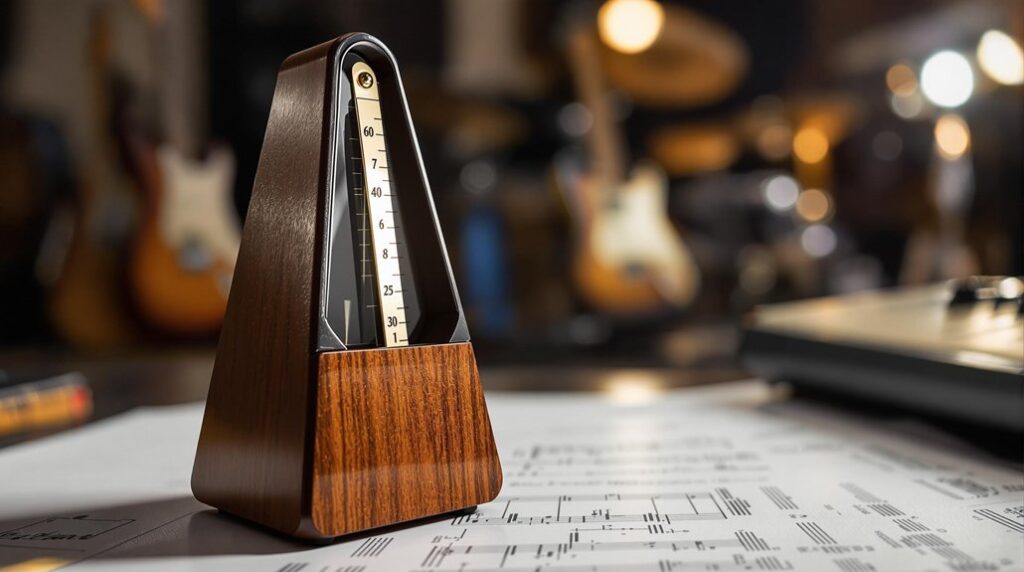Rhythm in serial and atonal music serves as a critical unifying element, compensating for the lack of conventional tonal centers. Composers such as Schoenberg and Webern utilized rhythmic patterns to maintain coherence and add emotional intensity. Techniques include irregular meters, syncopation, and polyrhythms, which disrupt traditional expectations and enhance structural integrity. These methods enable a complex interplay between rhythmic and pitch structures, guiding the listener through intricate musical landscapes. Innovations by composers like Milton Babbitt and Karlheinz Stockhausen exemplify the evolving use of rhythm in this genre, offering deeper insights into its transformative role.
Key Takeaways
- Rhythm compensates for the lack of tonal centers by providing a unifying element in atonal music.
- Rhythmic complexity in serial composition mirrors pitch structures, enhancing structural cohesion and listener engagement.
- Irregular meters and syncopation in atonal music disrupt traditional rhythmic expectations, creating interest.
- Rhythmic techniques in serialism include irregular durations, polyrhythms, and dynamic changes to enhance emotional tension.
- Temporal layering in atonal music allows multiple rhythmic patterns to coexist, enriching the musical texture.
Understanding Rhythm in Atonal Music
Exploring rhythm in atonal music reveals its essential role as a primary unifying element, compensating for the absence of traditional tonal centers. In the absence of a tonal foundation, composers utilize rhythm to impart a sense of structure and coherence.
Rhythmic unpredictability becomes a hallmark of atonal compositions, where patterns are often manipulated independently of pitch to enhance dissonance and emotional tension. Composers construct rhythms around the contour of a tone row, preserving its order while generating distinct rhythmic ideas.
This technique allows for the development of complex, shifting rhythmic landscapes that maintain the integrity of the tone row’s sequence. The incorporation of irregular meters and varying note durations further disrupts traditional rhythmic expectations, contributing to the avant-garde nature of atonal music.
Historical Background of Atonality and Serialism
The emergence of atonality in the early 20th century, championed by Arnold Schoenberg, Anton Webern, and Alban Berg, marked a radical departure from the tonal excesses of Romanticism, leading to the formation of the Second Viennese School.
Schoenberg’s development of the twelve-tone technique in the 1920s provided a structured approach to atonal composition by ensuring equal prominence to all twelve semitones.
Post-World War I cultural shifts and the rise of modernism further facilitated the acceptance and proliferation of atonal and serialist music, expanding the boundaries of musical expression beyond traditional harmonic frameworks.
Early 20th-Century Pioneers
Amid the cultural upheaval of the early 20th century, a revolutionary shift in musical paradigms emerged, led by visionaries such as Arnold Schoenberg, Anton Webern, and Alban Berg.
These early pioneers spearheaded the move away from traditional tonality, fundamentally altering the landscape of Western music. Schoenberg’s innovations, particularly his twelve-tone technique developed in the 1920s, established a systematic approach to composition. This method organized all twelve pitches of the chromatic scale into a series, ensuring equal treatment of each note and the absence of a tonal center.
Webern’s minimalism, characterized by his concise and highly structured compositions, further contributed to the evolution of atonality. His works often employed a sparseness and economy of means that contrasted sharply with the lush orchestrations of the Romantic era.
Key concepts introduced during this period included:
- Free atonality: Avoided traditional harmonic progressions and used intervallic cells for coherence.
- Twelve-tone technique: Systematically organized pitches to eliminate tonal hierarchy.
- Independence of musical elements: Emphasized by the Second Viennese School.
- Cultural influence: The aftermath of World War I spurred composers to seek new expressive methods.
- Departure from Romanticism: A response to its perceived emotional excesses.
These elements collectively marked a profound transformation in the compositional landscape.
Second Viennese School
A critical juncture in the evolution of Western music, the Second Viennese School represents a radical departure from the established norms of tonality, spearheading the development of atonality and serialism. Comprising Arnold Schoenberg, Alban Berg, and Anton Webern, this school advanced the twelve-tone technique in the early 20th century. Schoenberg’s innovations, particularly the introduction of the twelve-tone method in the 1920s, provided a systematic approach to atonal composition. This method, which utilizes a predetermined series of all twelve pitches, allowed for musical coherence without a tonal center.
The Second Viennese School’s works often reflected a reaction against the excesses of Romanticism, seeking new forms of expression through the exploration of emotional dissonance and the abandonment of traditional harmonic structures. Berg’s operas, such as “Wozzeck,” and Webern’s concise compositions exemplified the innovative use of atonality, emphasizing emotional depth and structural precision within their music. Collectively, their efforts laid the groundwork for later developments in serialism, profoundly influencing the trajectory of modern music throughout the 20th century.
| Composer | Key Contribution | Notable Works |
|---|---|---|
| Schoenberg | Twelve-tone method | “Pierrot Lunaire” |
| Berg | Operatic atonality | “Wozzeck” |
| Webern | Structural precision | “Five Pieces for Orchestra” |
| Schoenberg | Tonal center abandonment | “Suite for Piano” |
| Berg | Emotional dissonance | “Lulu” |
Post-War Developments
Building upon the revolutionary groundwork laid by the Second Viennese School, post-war developments in atonality and serialism saw composers pushing boundaries even further. The period following World War II catalyzed significant advancements as composers like John Cage explored indeterminate music and aleatoricism, challenging established compositional techniques.
This era marked a profound shift in composer intentions, moving towards innovative and abstract forms of musical expression. The Darmstadt School emerged as a pivotal influence, advocating for serialism that controlled musical elements through numerical proportions rather than recurring rows.
Arnold Schoenberg’s twelve-tone technique laid the foundation, but post-war serialism extended these principles to encompass rhythm, dynamics, and timbre, fostering greater rhythmic freedom. Key figures such as Milton Babbitt and George Perle played essential roles in codifying total serialism, where serial techniques governed all musical parameters.
This thorough framework allowed for a more integrated compositional approach. Key developments include:
- John Cage’s exploration of indeterminacy and aleatoricism.
- The Darmstadt School’s innovative serial strategies.
- Extension of Schoenberg’s twelve-tone technique to all musical parameters.
- Milton Babbitt and George Perle’s contributions to total serialism.
- A significant shift towards abstract and complex musical organization.
These advancements underscored a transformative era in atonality and serialism, redefining musical language and expression.
Rhythmic Techniques in Serial Composition
In serial composition, rhythmic techniques are meticulously constructed, often independent of pitch sequences, to enhance the structural complexity and atonal characteristics of the music.
Composers frequently implement irregular meters and syncopation, creating a temporal organization that resists traditional rhythmic expectations.
Serial Rhythmic Structure
Serial rhythmic structure in music composition represents an intricate method by which rhythm is meticulously organized alongside pitch into series, providing composers with the ability to manipulate rhythmic patterns with the same structural precision as pitch rows.
This approach allows for the creation of serial rhythmic patterns that imbue a composition with significant rhythmic complexity. By establishing specific temporal frameworks, composers can enhance the cohesion of the piece, ensuring that the rhythmic aspect complements the twelve-tone technique.
Key features of serial rhythmic structure include:
- Irregular durations: Utilization of varying note lengths to create unpredictability.
- Complex meters: Employment of time signatures that are unconventional, adding to the music’s atonality.
- Polyrhythms: Layering multiple rhythmic patterns to enrich the textural fabric of the composition.
- Frequent changes in rhythmic values: Dynamic shifts in rhythm within a single piece to maintain listener engagement.
- Emphasis on structural relationships: Integration of rhythm to highlight connections between different segments of the music.
Unlike traditional tonal music, where rhythmic patterns often follow predictable sequences, serial music leverages diverse and intricate rhythmic values.
This not only underscores the atonal nature of the composition but also contributes to a unified yet multifaceted auditory experience.
Temporal Organization Strategies
While serial rhythmic structure emphasizes the meticulous arrangement of rhythmic elements akin to pitch organization, the strategies for temporal organization in serial composition constitute a broader array of techniques that further deepen the rhythmic complexity. In serial composition, rhythm is often organized independently from pitch, allowing composers to explore unique rhythmic patterns that enhance the overall structure of the piece. Techniques such as syncopation, polyrhythms, and varied note durations are frequently employed to create complexity and maintain listener interest.
Composers like Milton Babbitt have been known to treat rhythmic series with the same importance as pitch series, thereby integrating rhythm as a critical component of the serial structure. This approach allows for temporal layering, where multiple rhythmic patterns coexist, and rhythmic juxtaposition, where contrasting rhythms are placed side by side to create tension and intrigue. In atonal music, rhythm can serve as a unifying element, providing coherence and direction even in the absence of tonal relationships. The use of non-repetitive, irregular rhythmic patterns contributes to a sense of unpredictability, challenging traditional expectations of musical form and flow.
| Technique | Description |
|---|---|
| Syncopation | Displacement of expected rhythmic patterns |
| Polyrhythms | Simultaneous use of contrasting rhythmic patterns |
| Varied Note Durations | Utilization of different note lengths to create interest |
| Rhythmic Series | Sequential arrangement of rhythmic values |
| Temporal Layering | Coexistence of multiple rhythmic patterns |
These techniques collectively enable composers to craft intricate and compelling temporal structures within serial music.
Impact of Rhythm on Listener Perception
Rhythm serves as a fundamental element in shaping listener perception, particularly in the domains of atonal and serial music. It provides a structural framework that compensates for the absence of tonal centers, consequently enhancing listener engagement.
In serial compositions, rhythmic patterns are meticulously organized into series that mirror pitch structures, offering a cohesive form that aids cognitive processing. This deliberate structuring allows listeners to discern patterns and anticipate musical developments, fostering a deeper connection with the music.
Effective management of mid-range frequencies can also enhance the clarity of rhythmic elements, making them more distinct and impactful. In atonal music, rhythm creates a sense of tension and release, guiding listeners through compositions lacking traditional harmonic resolutions. The varied rhythmic elements become pivotal in maintaining listener interest and steering through the complex soundscape.
- Rhythm instills structure and coherence in atonal and serial music.
- Specific rhythmic patterns in serial compositions enhance the perception of musical form.
- Tension and release in rhythmic elements guide listeners through atonal pieces.
- Rhythmic structuring aids cognitive processing, helping listeners identify patterns.
- Manipulation of rhythmic elements like syncopation challenges listener expectations.
Consequently, rhythm’s role in atonal and serial music extends beyond mere temporal organization, profoundly impacting how listeners perceive, engage with, and cognitively process the music.
Case Studies of Rhythmic Innovations
Many groundbreaking rhythmic innovations have emerged from the works of influential 20th-century composers, profoundly altering the landscape of atonal and serial music. In this domain, rhythm often serves as a primary unifying element, providing essential structure and coherence in the absence of traditional tonal centers.
Milton Babbitt’s and Karlheinz Stockhausen’s rhythmic developments illustrate this paradigm shift. For instance, integral serialism, championed by Stockhausen, expanded rhythmic organization through numerical proportions, thereby systematizing rhythm alongside pitch and dynamics. This yielded a more cohesive musical language, where rhythm played a vital role in binding the elements of composition. Stockhausen’s approach can be likened to the meticulous balancing of levels performed by mixing engineers to achieve an artistic vision.
Pierre Boulez’s utilization of intricate rhythmic patterns and groupings exemplifies how rhythmic complexity can create forward momentum and tension, enhancing listener engagement in atonal music.
Similarly, Anton Webern’s incorporation of irregular time signatures and polyrhythms introduced rhythmic interplay that juxtaposed contrasting elements, fostering unpredictability and tension. These techniques underscored the importance of rhythmic cells, manipulated through transposition and inversion akin to pitch rows, fostering diverse rhythmic expressions aligned with serialism principles.
Collectively, these rhythmic innovations provided a robust framework that enriched the expressive potential of atonal and serial compositions, ensuring their enduring impact on contemporary music.
Critiques and Future Directions
Despite the transformative contributions of 20th-century composers to rhythmic innovation, a critical examination reveals notable challenges and areas for future exploration. Critics argue that the rhythmic complexities inherent in serial and atonal music often present perceptual difficulties for listeners, obstructing their ability to discern underlying structures and relationships within compositions. This issue of listener engagement prompts a closer look at rhythmic accessibility.
Theorists like Nicolas Ruwet suggest that the rigid rhythmic frameworks of serialism, akin to linguistic structures, may constrain creative expression and spontaneity. To address these concerns, future directions in rhythmic composition might consider more fluid and indeterminate patterns, as exemplified by John Cage’s aleatoric techniques.
Key areas for future exploration include:
- Investigating cognitive aspects of rhythm in atonal music to enhance listener engagement.
- Balancing rhythmic innovation with accessibility to facilitate audience appreciation.
- Employing indeterminacy to introduce spontaneity and dynamic variability.
- Reassessing the constraints imposed by rigid serialist structures.
- Encouraging interdisciplinary research to understand emotional responses to complex rhythms.
Ongoing discussions in contemporary music highlight the importance of reconciling the sophisticated rhythmic elements of serialism with the practical aspects of listener accessibility, aiming to foster a more inclusive and emotionally resonant musical experience.
Frequently Asked Questions
What Is the Role of Rhythm in Music?
Rhythm’s significance in music lies in its ability to establish structure, drive momentum, and evoke emotional responses. Rhythmic complexity can enhance a composition’s depth, creating intricate textures and dynamic contrasts that enrich the overall auditory experience.
What Is Serialization of Rhythm?
Serialization of rhythm involves organizing rhythmic patterns into a predetermined series, thereby forming complex rhythmic structures. This technique prioritizes rhythm’s independence, allowing for intricate manipulations such as transposition and retrograde, similar to pitch serialization in twelve-tone composition.
Is Serialism Atonal Music?
Serialism often encompasses atonal music due to its lack of a tonal center. However, not all serial techniques are strictly atonal, as they can incorporate tonal elements or hierarchical rhythmic structures, thereby retaining some tonal qualities.
What Are the Main Musical Features of a Serialist Piece of Music?
A serialist piece of music primarily features the twelve-tone technique, organizing pitches into a predetermined pitch class series. It often includes transformations such as retrograde and inversion, with complex rhythmic and dynamic structures enhancing the composition’s textural detail.
Conclusion
In sum, rhythm plays a pivotal role in shaping the structural and expressive dimensions of serial and atonal music. Through historical analysis, it is evident that rhythmic techniques in serial composition have markedly influenced listener perception and musical innovation. Case studies underscore the diverse rhythmic strategies employed by composers, highlighting their contributions to the evolution of the genre. Future research should further explore the interplay between rhythm and other musical elements, aiming to deepen the understanding of atonality and serialism’s complex nature.




